VERNACULAR ARCHITECTURE AND MATERIALS
Vernacular Architecture is predominantly an architectural style that manifests local traditions. Vernacular Architecture is easy to identify as local construction with traditional local materials and resources is used. It reflects the local cultural and geographical features through paintings, roof styles, etc. along with unique construction technology built by local builders using their expertise. These structures are constructed by local builders, owners themselves, or the community to gratify the requirements along with considering and incorporating the values, lifestyle, and economy. Vernacular Architecture not only is sustainable but also represents and establishes a cultural identity of the specific group of people and enhances the bond between the place and the people.
Vernacular Architecture belongs to a specific time and place and is not duplicated from other regions as many attributes influence the architecture of a place name, available skilled workforce and resources; local technology, materials, and climate; environmental and economic conditions, etc.
COMMON CHARACTERISTICS OF VERNACULAR ARCHITECTURE
- Orientation influences the aspect of a structure being climate-responsive. Courtyards used in the interior are a very good example of using correct orientation to release the hot summer air and create pleasing thermal conditions.
- In Vernacular architecture, the overhanging eaves provide shading to the windows, external walls, or any openings from the scorching sun. These eaves help in interrupting the sunlight from directly penetrating the interiors.
- The relative humidity of a building is managed by cross-ventilation. Structures built-in hot and humid climate need cross ventilation the most to maintain a pleasant interior.
- These structures reflect the culture not only through their exteriors or the materials used but the interiors are often decorated with articles that symbolize the culture and represent the richness of their aesthetics.
BENEFITS OF VERNACULAR ARCHITECTURE
Vernacular Architecture is built and designed at the same place and has many benefits other than being cost-effective for instance,
- Making the most of the local traditions and the knowledge they have to save the time invested in doing research.
- To make the structure sustainable and energy-efficient local materials and resources are used.
- Vernacular Architecture makes the people more amicable and feels at home with the new construction as the structure provides a prime connection between the environment and the users.
- As the structures are designed considering the local climate condition they perform comparatively well.
EXAMPLES OF VERNACULAR ARCHITECTURE STYLES IN INDIA
India represents a variety of traditions and this diversity is visible even in architecture. Several rural areas showcase different structures build with the local materials for the local people. Listed below are a few examples of vernacular architecture styles seen in India
- Assam Type House: As the name suggests Assam type houses are spotted in the northeast state in India. To resist the earthquakes the houses are usually single-storied and are detached from the adjacent houses. Locally available materials like wood, reed mesh, bamboo are used for construction. The light tin roof and wooden flooring are used widely as these materials are resistant to earthquakes. Assam-type houses are cost-effective construction that is durable, lightweight, and sustainable.
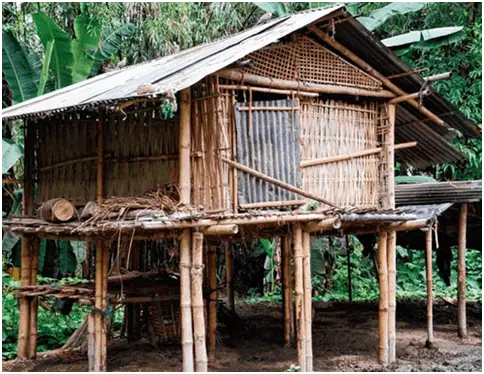
- Bunga: Bungas are traditional houses that are tenacious and are resistant to large earthquakes thus are widely seen in states like Rajasthan and Gujarat (Kutch) that are earthquake-prone. To minimize the surface exposure to the hot and dry weather the houses are circular and to maintain thermal comfort in the interiors the walls are made of mud and roofs are thatched. To support these thatched roofs two wooden posts that bear the entire weight of the roof are placed across the house on which the roof rests. In addition to mud other locally available materials like clay, bamboo, straw, timber, etc. are also used in the construction. Bungas belong to a culture that is very aesthetical and the same is reflected in the interiors on Bungas where mirror patterns are used for decoration.
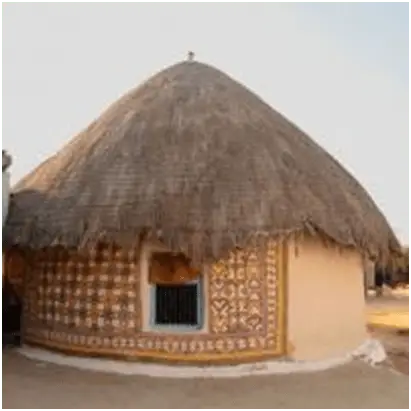
- Laterite Structure: Laterite is the material that is seen in ancient temples, maritime forts, and traditional houses. As the way of using laterite in construction advanced, laterite bricks are now introduced in northern Kerala along with replacing cement mortar with laterite for brick masonry construction. Laterite structures constructed in Goa are plastered with a fuse of lime and earth or lime alone or rather left un-plastered. These houses have sloping roofs with huge overhangs as the monsoons are quite heavy in these regions and restrict the sunlight.
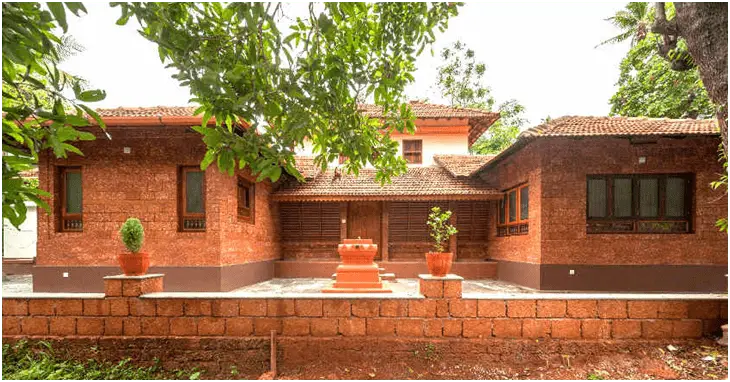
- Warli House: Warli houses are constructed using mud, small stems of Strobilanthes callosa plant, and bamboo. These houses are seen in the state of Maharashtra where there are heavy monsoons and extremely hot summers. The roofs are thus thatched with palm leaves that protect them from leaking in the monsoons though it has to change periodically to maintain doing so. On the other hand, paddy straws added to the roof construction keeps the interiors cool during summers. To maintain the thermal comfort inside the house the walls are plastered with mud and the floors are plastered with cow dung. All these factors make a Warli house climate-responsive and connect with local rural people.
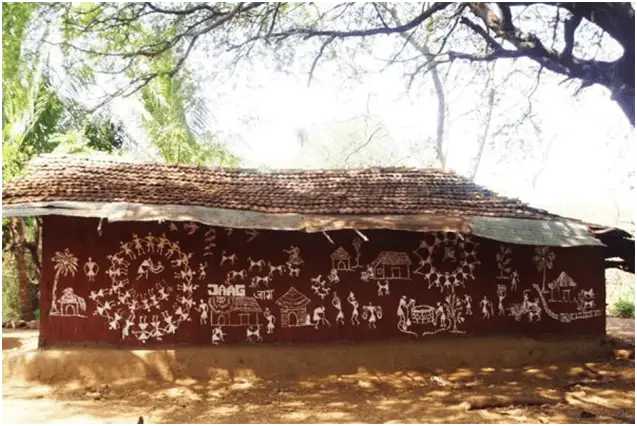
- Traditional Bamboo house: Traditional bamboo houses are majorly sited in north-east India where there are mountains, plains, and frequent floods due to heavy monsoons. Bamboo is used to distribute the load whereas the walls are constructed using cow-dung and mud along with bamboo. Bamboo is treated correctly thus makes the structure durable, water-resistant and sustainable along with being cost-effective due to the local availability of the material. The entire structure including the roofs and floors is made of bamboo. As the floors are weaved with bamboo they do not restrict but rather allow the flood to flow in which is one of the prime theories of sustainable housing and prevents physical destruction.
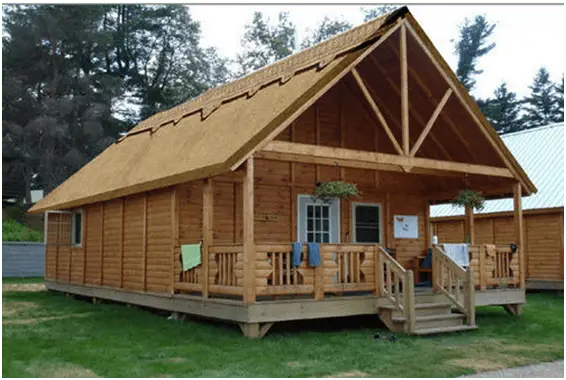
- Zawlbuk House: Zawlbuk house is a dormitory that is located close to the chief’s residence as Zawlbuk is the house for all the bachelor’s in the village where they are taught their culture and skills. These houses are seen in Mizoram in the north-eastern tribes. A strong bamboo mat which is woven in a specific pattern is used to construct the floors of these houses. If the house is to be built on a slope a fuse of wood and bamboo is used to resist the pressure and load on the house. There are bamboo partitions in the interiors for visual screening and maintaining privacy. To protect the house from heavy monsoon the roof is constructed using split bamboo and topped with thick thatch, straw, or leaves to cover the bamboo and create a closed environment.
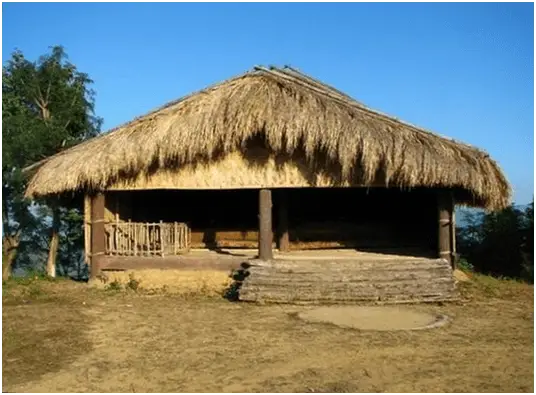
MATERIALS USED IN VERNACULAR ARCHITECTURE
Architecture involves ideating the materials and form considering the local culture, geographic and topographic conditions, and all other factors that impose direct or indirect influence on the architecture of the place. In vernacular architecture materials used for construction are readily and locally available and are used in their technique to construct a shelter that satisfies the need of the people. Following are the four most commonly used materials in vernacular architecture.
- Earth: Earth is one of the chief construction materials in vernacular architecture. Earth is formed by uncemented mineral grains that are formed as a result of the weathering of organic matter, rocks, and water. Earth is one of the most sustainable construction materials in vernacular architecture and if used and maintained correctly earth does not lead to any depletion of resources as it is renewable also it does not hamper the environment with pollution or biological changes throughout the entire process. Numerous experiments have been done with the earth as new environmentally and economically sustainable housing are been introduced. Laterite and clay blocks along with rammed earth and clay soil are the most commonly used earthen construction materials in vernacular architecture.
- Bamboo: Bamboo is one of the best options to be used as a construction material as it is very commonly available which makes using bamboo cost-effective. Along with being cost-effective bamboo is a fast-growing and renewable material and thus is widely grown. Bamboo if treated correctly is durable and water-resistant that makes it one of the best solutions to construct the entire house with. Though bamboo is lightweight it is strong enough to carry the load and withstand the sun, wind, rain, earthquake, etc. Bamboo has many species and according to the location and availability of bamboo the selection is made.
- Laterite: Laterite is the reddish surface layer that is formed on rocks that contain rich iron and aluminum deposits that get weathered in the hot and wet tropical climate. Laterite is used in the construction of flooring and wall units as its consistency is clay-like and thus can hold more water than other commercial soils. It is also used in the construction of roadways and to fill the foundations when compacted correctly. In few regions, laterite is moistened and molded into dense bricks for construction. This masonry requires less mortar and is cured according to the required strength. Laterite’s thermal nature acts as a coolant for the building and thus is widely used in regions with hot summers making the material sustainable.
- Timber: Timber is used widely in different forms for vernacular architecture because of the properties and availability. Timber is strong and can carry the load possessing resistance against shocks due to earthquake or other vibrations. If treated correctly timber proves to be very durable and withstands against all-weather conditions. Its low production energy and easy availability make it economical for vernacular architecture. The type of timber used and the skills are different from place to place yet the workability is easy overall. Timber can be used to construct absolutely every element of a building including roofing, walls, flooring, formwork, scaffolding, etc., doors, windows, staircase, furniture, and decoration articles.
In a nutshell, vernacular architecture probably might not be awarded for a great design or any technology innovation but it is an inherent part of building and architecture. These structures are more socially conscious as they are built with the traditional building style. Vernacular architecture is the line that connects climate, people, and architecture. Thus, it is the most durable, sustainable, and versatile style of architecture that preserves and reflects the local traditions along with satisfying the structural needs of the people.
References:
- https://www.archdaily.com/951667/what-is-vernacular-architecture
- https://www.thespruce.com/vernacular-architecture-4801653
- https://www.designingbuildings.co.uk/wiki/Vernacular_architecture#Benefits_of_vernacular_architecture
- https://architizer.com/blog/practice/materials/local-materials-and-techniques-in-ghana/
- https://gharpedia.com/blog/importance-of-vernacular-architecture-in-india/
